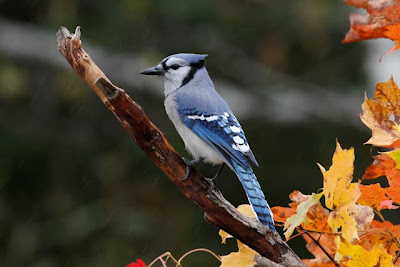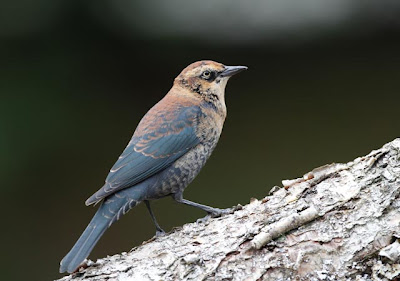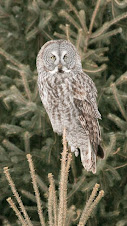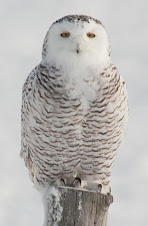WINTER FINCH FORECAST 2010-2011
This winter's theme is that some finch species will irrupt into southern
Canada and the northern United States, while other species will remain
in the north. As an example, Common and Hoary Redpolls will move south
whereas Pine Grosbeaks will stay in the north. See individual finch
forecasts below for details. Three irruptive non-finch passerines are
also discussed.
KEY FINCH TREE CROPS
Key trees in the boreal forest affecting finch abundance and movements
are white and black spruces, white birch, and mountain-ashes. South of
the boreal in the mixed coniferous/deciduous forest region, white pine
and hemlock are additional key finch trees. Other trees play a lesser
role, but often boost or buffer main seed sources. These include
tamarack (American larch), balsam fir, white cedar, yellow birch and
alders.
SPRUCE: White spruce cone crops are very good to excellent across the
northern half of the boreal forest in Canada, except Newfoundland where
crops are poor. However, spruce crops are much lower in the southern
half of the boreal forest and poor in the mixed forest region of central
Ontario such as
Algonquin Park. The spruce crop is good to very good in
central and northern Quebec, but generally poor in Atlantic Canada and
northeastern United States. Spruce cone abundance is very good in the
foothills of Alberta and eastern side of the Rocky Mountains in Canada,
but poor in the southern half of British Columbia and in Washington
State. A bumper white spruce cone crop in southern Yukon attracted high
numbers of White-winged Crossbills and Pine Siskins this past summer and
they may remain there through the winter. Spruce crops are generally
poor in the Atlantic Provinces, New York State and New England States.
WHITE PINE: Cone crop is spotty with scattered good to excellent crops
across Ontario. White pine crops are low in Atlantic Canada, New York
and New England States. HEMLOCK: Cone crop is poor in Ontario and
elsewhere in the East. WHITE BIRCH: Crop is poor across the boreal
forest of Canada and in central Ontario, but birch crops are much better
in southern Ontario south of the Canadian (Precambrian) Shield.
MOUNTAIN-ASH: Berry crops are generally excellent across Canada and
Alaska, but poor in Newfoundland.
INDIVIDUAL FINCH FORECASTS
Forecasts apply mainly to Ontario, but neighboring provinces and states
may find they apply to them.
PINE GROSBEAK: The Pine Grosbeak breeds in moist open habitats across
northern Ontario. It is most common in northeastern Ontario which
receives more precipitation than northwestern Ontario (Peck and Coady in
Atlas of Breeding Birds of Ontario 2007). Most Pine Grosbeaks should
stay in the north this winter because the mountain-ash berry crop is
generally excellent across the boreal forest of Canada and Alaska,
except for a poor crop in Newfoundland. The feeders at the Visitor
Centre in
Algonquin Park usually attract Pine Grosbeaks even in
non-flight winters. If Pine Grosbeaks wander into southern Ontario they
will find good crops of European mountain-ash berries and ornamental
crabapples.
PURPLE FINCH: This finch winters in the north when the majority of
deciduous and coniferous seed crops are abundant, which is not the case
this year. Most Purple Finches will migrate south of Ontario this fall.
A few may frequent feeders in southern Ontario. Purple Finch numbers
have declined significantly in recent decades due in part to a decrease
of spruce budworm outbreaks since the 1980s (Leckie and Cadman in Atlas
of Breeding Birds of Ontario 2007).
RED CROSSBILL: This crossbill comprises at least 10 "call types" in
North America. Each type has its particular cone preferences related to
bill size and shape. These crossbill types may be at an early stage of
evolving into full species and some may already qualify for species
status. They are exceedingly difficult to identify in the field and much
remains to be learned about their status and distribution. Types 2 and 3
and probably 4 occur regularly in Ontario (Simard in Atlas of Breeding
Birds of Ontario 2007). Most Red Crossbill types prefer pines, but the
smallest-billed Type 3 (sitkensis subspecies of AOU Check-list 1957)
prefers the small soft cones of hemlock in Ontario. It will be absent
this winter because hemlock crops are poor. Type 2 may be the most
frequently encountered Red Crossbill in the province. Some Type 2s
should be found this winter where white pine crops are very good such as
northeastern
Algonquin Park and along Highway 69 north of the French
River in Sudbury District. Possible this winter are other Red Crossbill
types associated with red pine, which has some locally good crops.
WHITE-WINGED CROSSBILL: High numbers of White-winged Crossbills are
currently concentrated in southern Yukon where the white spruce cone
crop is bumper. These may remain there this winter. This crossbill's
highest breeding abundance in Ontario is in the spruce dominated Hudson
Bay Lowlands and adjacent northern Canadian Shield (Coady in Atlas of
Breeding Birds of Ontario 2007). Most Ontario reports this past summer
came from this area where the white spruce cone crop is heavy. Some were
singing and presumably nesting. They might remain in northern Ontario
this winter if seed supplies last. Some may disperse southward as spruce
seeds run low and could appear in southern Ontario and northern United
States. However, they will be rare or absent this winter in traditional
areas such as
Algonquin Park where spruce and hemlock cone crops are
very poor. Unlike the Red Crossbill, the White-winged Crossbill has no
subspecies (monotypic) or call types in North America. Its nomadic
wanderings across the boreal forest mix the populations and allow gene
flow, which inhibits geographical variation and the formation of
subspecies.
COMMON REDPOLL: Redpolls should irrupt into southern Canada and the
northern United States this winter. The Common Redpoll's breeding range
in Ontario is mainly in the Hudson Bay Lowlands from the Manitoba border
southeast to southern James Bay (Leckie and Pittaway in Atlas of
Breeding Birds of Ontario 2007). Redpolls in winter are a birch seed
specialist and movements are linked in part to the size of the birch
crop. The white birch crop is poor across much of northern Canada.
Another indicator of an upcoming irruption was a good redpoll breeding
season in 2010 with double and possibly triple broods reported in
Quebec. High breeding success also was reported in Yukon. Samuel Denault
of McGill University has shown that redpoll movements at Tadoussac,
Quebec, are more related to reproductive success than to tree seed crops
in the boreal forest. Redpolls will be attracted to the good birch seed
crops on native white birch and European white birch in southern Ontario
and to weedy fields. They should be frequent this winter at feeders
offering nyger and black oil sunflower seeds. Watch for the larger,
darker and browner "Greater" Common Redpolls (rostrata subspecies) in
the flocks. It is reliably identified by its larger size and
proportionally longer thicker bill and longer tail in direct comparison
with "Southern" Common Redpolls (nominate flammea subspecies).
HOARY REDPOLL: The breeding population in northern Ontario is the most
southerly in the world (Leckie and Pittaway in Atlas of Breeding Birds
of Ontario 2007). Careful checking of redpoll flocks should produce a
few Hoary Redpolls. There are two subspecies. Most Hoaries seen in
southern Canada and northern United States are "Southern" Hoary Redpolls
(exilipes subspecies). During the last large redpoll irruption in
2007/2008, several "Hornemann's" Hoary Redpolls (nominate hornemanni
subspecies) were found and supported by photographs. Hornemann's Redpoll
was previously regarded as a great rarity south of the Arctic, but it
may be more frequent than formerly believed. Hornemann's is most
reliably identified by its much larger size in direct comparison with
flammea Common Redpolls or exilipes Hoary Redpoll. Note that white birds
loom larger than life among darker birds and size illusions are
possible.
PINE SISKIN: Similar to the White-winged Crossbill, there are currently
high numbers of siskins in southern Yukon attracted to a bumper white
spruce cone crop. They could stay in Yukon for the winter. Siskins show
a tendency for north-south migration, but are better considered an
opportunistic nomad (Pittaway in Atlas of Breeding Birds of Ontario
2007). Banding recoveries show that siskins wander from coast to coast
searching for conifer seed crops. They were uncommon this past summer in
Ontario and the Northeast. Some might winter in northern Ontario where
the white spruce crop is heavy. However, siskins are currently uncommon
in the Northeast so there are potentially only very small numbers that
could irrupt south in eastern North America.
EVENING GROSBEAK: Highest breeding densities in Ontario are found in
areas with spruce budworm outbreaks. Current breeding and wintering
populations are now much lower than a few decades ago mainly because
large spruce budworm outbreaks have subsided since the 1980s (Hoar in
Atlas of Breeding Birds of Ontario 2007). If some come south this
winter, they will find large crops of Manitoba maple (boxelder) seeds
and plenty of black oil sunflower seeds at feeders waiting for them.
THREE MORE IRRUPTIVE PASSERINES
BLUE JAY: This will be an average flight year with smaller numbers than
in 2009 along the north shorelines of Lakes Ontario and Erie. Beechnut
crops are poor to none. Acorn crops are spotty, but considerably better
than last year. More Blue Jays will winter in Ontario than last winter
due to caches of acorns and other mast crops.
RED-BREASTED NUTHATCH: This nuthatch is a conifer seed specialist when
it winters in the north, thus its movements are triggered by the same
crops as the boreal winter finches. The southward movement, which began
in the summer, signaled the generally poor cone crops on spruces, balsam
fir and white pine in the mixed coniferous/deciduous forest region
across Ontario and in Atlantic Canada, New York and New England States.
Red-breasted Nuthatches will be very scarce this winter in central
Ontario such as
Algonquin Park. White spruce crops are excellent in the
northern half of the boreal forest, but it is uncertain how many
Red-breasted Nuthatches will winter that far north.
BOHEMIAN WAXWING: Most Bohemians Waxwings will stay close to the boreal
forest this winter because mountain-ash berry crops are excellent across
Canada, except in Newfoundland. Some should wander south to traditional
areas of eastern and central Ontario such as Ottawa and Peterborough
where planted European mountain-ashes and ornamental crabapples are
frequent. If you get the opportunity to visit northern Ontario this
winter, you may see Bohemian Waxwings and Pine Grosbeaks feeding
together on mountain-ash berries. The grosbeaks eat the seeds and
discard the flesh whereas the waxwings swallow the entire berry and
sometimes eat the fleshy leftovers of the grosbeaks. The similar
coloration of Bohemian Waxwings and female Pine Grosbeaks may be
functional, perhaps reducing interspecific aggression when they feed
together.
WHERE TO SEE FINCHES
A winter trip to Algonquin Park is a birding adventure. The park is a
three hour drive north of Toronto. Finch numbers will be low in
Algonquin forests this winter, but the feeders at the Visitor Centre
should attract redpolls, Evening Grosbeaks and Pine Grosbeaks. Gray Jays
frequent the suet feeder and sometimes Pine Martens and Fishers feed on
the suet and sunflower seeds. A high observation deck overlooks a
spectacular boreal wetland and black spruce/tamarack forest. Eastern
Timber Wolves (Canis lycaon), which until recently was a subspecies of
the Gray Wolf (C. lupus), are seen occasionally from the observation
deck feeding on road-killed Moose put out by park staff. The Visitor
Centre and restaurant at km 43 are open on weekends in winter.
Arrangements can be made to view feeders on weekdays. For information,
call the Visitor Centre at 613-637-2828. The Spruce Bog Trail at km 42.5
near the Visitor Centre and the gated area north on the Opeongo Road are
the best spots for finches, Gray Jay, Boreal Chickadee, Spruce Grouse
and Black-backed Woodpecker.
ACKNOWLEDGEMENTS: I thank staff of the Ontario Ministry of Natural
Resources from across the province designated by an asterisk* and many
others whose reports allow me to make annual forecasts: Dennis Barry
(Durham Region and Washington State), Eleanor Beagan (Prince Edward
Island), Ken Corston* (Moosonee), Pascal Cote (Tadoussac Bird
Observatory, Quebec), Mark Cranford, Samuel Denault (Monts-Pyramides,
Quebec), Bruce Di Labio (Eastern Ontario), Carrolle Eady (Dryden),
Cameron Eckert (Yukon), Brian Fox* (South Porcupine), Francois Gagnon
(Abitibi, Lac Saint-Jean, Saguenay, Quebec), Marcel Gahbauer (Alberta),
Michel Gosselin (Canadian Museum of Nature), David Govatski (New
Hampshire), Charity Hendry* (Ontario Tree Seed Plant), Leo Heyens*
(Kenora), Tyler Hoar (Central and Northern Ontario), George Holborn*
(Thunder Bay), Eric Howe*, Peter Hynard (Minden), Jean Iron
(Northeastern Ontario and James Bay), Bob Knudsen (Sault Ste Marie,
Ontario), Bruce Mactavish (Newfoundland), David McCorquodale (Cape
Breton Island), Erwin Meissner (Massey), Andree Morneault* (North Bay to
Renfrew County), Brian Naylor* (North Bay to Renfrew County), Martyn
Obbard*, Stephen O'Donnell (Parry Sound District), Fred Pinto* (North
Bay to Renfrew County), Dean Phoenix*, Rick Salmon* (Lake Nipigon),
Harvey and Brenda Schmidt (Creighton, Saskatchewan), Don Sutherland*
(Northern Ontario), Ron Tozer (Algonquin Park), Declan Troy (Alaska),
Gert Trudel (Gowganda), Mike Turner* (Haliburton Highlands), John
Woodcock (Thunder Cape Bird Observatory), Alan Wormington, and Matt
Young of Cornell University, who provided detailed information about
seed crops in New York and other eastern states. Jean Iron and Michel
Gosselin made many helpful comments and proofed the forecast.
LITERATURE CITED: Atlas of the Breeding Birds of Ontario 2007 by editors
M.D. Cadman, D.A. Sutherland, G.G. Beck, D. Lepage and A.R. Couturier.
http://www.birdsontario.org/atlas/index.jsp
Ron Pittaway
Ontario Field Ornithologists
Minden, Ontario
23 September 2010




















